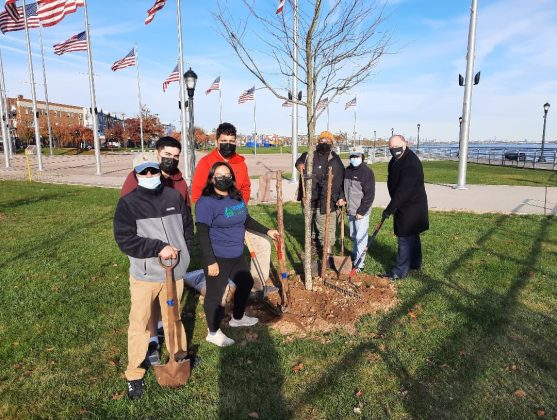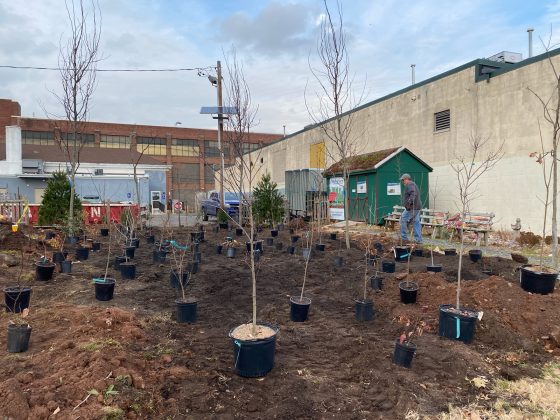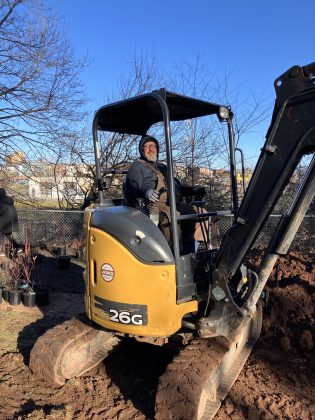micro forests for macro change
With a population of 135,000 people living in less than 12 sq. miles, the dense urban neighborhoods of Elizabeth, NJ – located next to one of the busiest ports on the east coast, in the flight path of Newark Airport, and at the heart of several major industrial transportation routes – faces a host of environmental challenges. With a minimal tree canopy and lack of open green space, the city gets HOT during the summer months which exacerbates health issues, like asthma and COPD, caused by poor air quality. When it rains, and it frequently does as Elizabeth receives approximately 48 inches of rain annually, 26% more than the national average, the outdated stormwater system can’t keep up. Extreme storms and flash flooding events are happening more frequently and are causing more damage. When Hurricane Ida hit in 2021 hundreds of residents were displaced and the city is still trying to fully recover from the damage. With little open space, but a growing urgency to tackle these challenges, climate justice advocates have had to identify creative ways to make the most of the available land.
Trees for climate resilience

Groundwork Elizabeth has been at the forefront of this movement to find creative solutions to the impacts of the climate crisis. Using available GIS data and information collected through their own community science and outreach projects, the Mayor’s Youth Council – a subset of Groundwork Elizabeth’s Green Team program that provides opportunities for young people to propose and implement local climate resilience solutions with the backing of the Mayor and municipal government – has sited and planted over 400 trees in parks and along streets in formerly redlined, climate-vulnerable neighborhoods. Street trees have many benefits, from flood and heat mitigation to air and water purification, to biodiversity increases. Figuring out how to magnify the scale of climate resilience impact of trees was next on the agenda for Groundwork Elizabeth.
Enter the micro forest. In September 2021, the NJ Conservation Foundation approached Groundwork Elizabeth about using the Japanese Miyawaki method to build small, concentrated forests throughout the city. The micro forest makes a huge impact on climate resilience without taking up a lot of space, making it the perfect solution for a city like Elizabeth. This method involves planting between 15 and 30 species of native trees and shrubs randomly together in a small plot to speed up the natural selection process.
As John Evangelista, Director of Operations at Groundwork Elizabeth, explains, “The way [the Miyawaki method] was created, you overplant an area and it’s kind of survival of the fittest. You are going to have some die back and you go into it knowing that. We’ve only lost 4 trees so far, which is almost unheard of. You will lose between 3-5% [of the trees] depending on what happens. The reason to overplant and to force them to grow is that it increases the growth rate.”

After 3-5 years, the micro forests will be self-sufficient, no longer requiring regular watering and maintenance, and in just 20 years, they will reach maturity, providing shade, increasing soil permeability, improving air quality, and providing habitats for native species. Fast-growing solutions like micro forests are crucial to preparing for the increasingly prevalent impacts of climate change.
The nuts & bolts of building a micro forest
Collaborating with the city government and community groups, Groundwork Elizabeth compared current-day temperature, impervious surface prevalence, and tree canopy coverage data to historic redlining maps to identify the local areas at the greatest risk of climate impacts. Through the Climate Safe Neighborhoods program, Groundwork Elizabeth determined that neighborhoods that were formerly redlined have a much higher prevalence of impervious surfaces, lower levels of tree canopy coverage, and increased land surface temperatures.
Using these maps, the team determined where micro forests could have the most benefit. Their goal is to plant in a diverse range of visible locations so as many community members as possible can see the micro forests and ask questions. As Executive Director of Groundwork Elizabeth, Jonathan Phillips puts it, “There’s an immediate benefit [to these micro forests]. People see these micro forests and they say, ‘What is that? Why are you doing that?’ And they start getting interested in trees and they start asking more questions and become interested in the environment. And they realize, ‘Why don’t we have more trees in the city?’ [The benefits of micro forests] are things that grow right in front of your eyes.” As they grow, these micro forests become living classrooms.

Finding a suitable location for a micro forest may be one of the most important decisions, but it is also one of the most challenging. John explains, “The biggest part of it is knowing who owns the land and that the land won’t be touched [once the forest has been planted]. We don’t want to plant this forest and in six years have to rip it out just as it’s getting established. That’s where it gets a little tricky sometimes.”
The team has run into this problem with a proposed micro forest in a great location: a very busy intersection of North Avenue and Raymond Terrace, right next to Kean University. As GWE began to plan, they found out that the State owned that piece of land. The project has been put on pause as they seek new approvals for the plans. “You try to do your due diligence but things still happen. One thing you have to know about us at [Groundwork] Elizabeth is we don’t give up, so we’re going to get this done,” Jonathan said. While they wait on approvals from the State, Groundwork Elizabeth has moved ahead with planting micro forests in two other locations.
Once a location is identified and secured, the process can move ahead quickly. The team begins by preparing the plot for planting, including soil testing, pavement removal, and brownfield remediation by replacing the top soil layer with leaf litter from a mature NJ forest to mimic the proper ground conditions. Then the two-week planting process can begin. Groundwork Elizabeth starts with 3-ft, local trees and spaces them throughout the micro forest, using a backhoe to help speed up the digging and planting.


Youth have been heavily involved in this initiative, conducting community engagement and outreach, planting, and maintaining the micro forests once they have been planted. In total, 42 youth from the Mayor’s Youth Council, Groundwork Elizabeth’s Green Team, and the Housing Authority of the City of Elizabeth’s Youth Adventure and Action Team (HACE HEAT) have contributed to the project.

changing places, changing lives
At the start of 2023, two of their original five pilot micro forests have already been put in the ground, the first of which was built on Groundwork Elizabeth’s micro-farm. This 40 ft by 50 ft plot now holds 178 trees of 12 different species, including fruit trees to support biodiversity. The second completed micro forest is composed of 170 trees on a slightly larger plot at a municipal housing site in Elizabeth. Groundwork Elizabeth is planning to get the remaining micro forests off the ground this year, with the final one scheduled for completion in the spring of 2024.

Students at the local Kean University are using baseline carbon sequestration and soil data from before the micro forests were implemented to quantify the impacts of the micro forests, and it is clear that the 200 trees in these two micro forests are already improving the soil and air quality. Flood and heat mitigation, as well as air purification, will follow as the forests mature in the coming years and the trees provide shade, protect against soil erosion, and absorb stormwater. While the long-term impacts on the health and well-being of residents are yet to be measured, residents and businesses have already begun to notice the impact of the trees on their quality of life. While flooding has been a frequent challenge in the neighborhood, one local businessman has noted that he has not had any flooding challenges at all since the trees went into the ground!
Groundwork Elizabeth is now the top micro forest expert in NJ, and the team is in a position to provide advice and technical assistance to other environmental justice organizations across the whole state. Jonathan explains, “It’s really exciting… When people hear about [this project], they get excited about it. There’s potential for us to go into other parts of NJ and probably a lot of potential for other Groundwork Trusts to do this in their own communities and local communities nearby.” Groundwork Elizabeth has already been receiving requests to plant micro forests from other towns and counties, and the team sees this project as being a central focus of GWE in the coming years. “This is who we are right now.”
To learn more, visit Groundwork Elizabeth.
